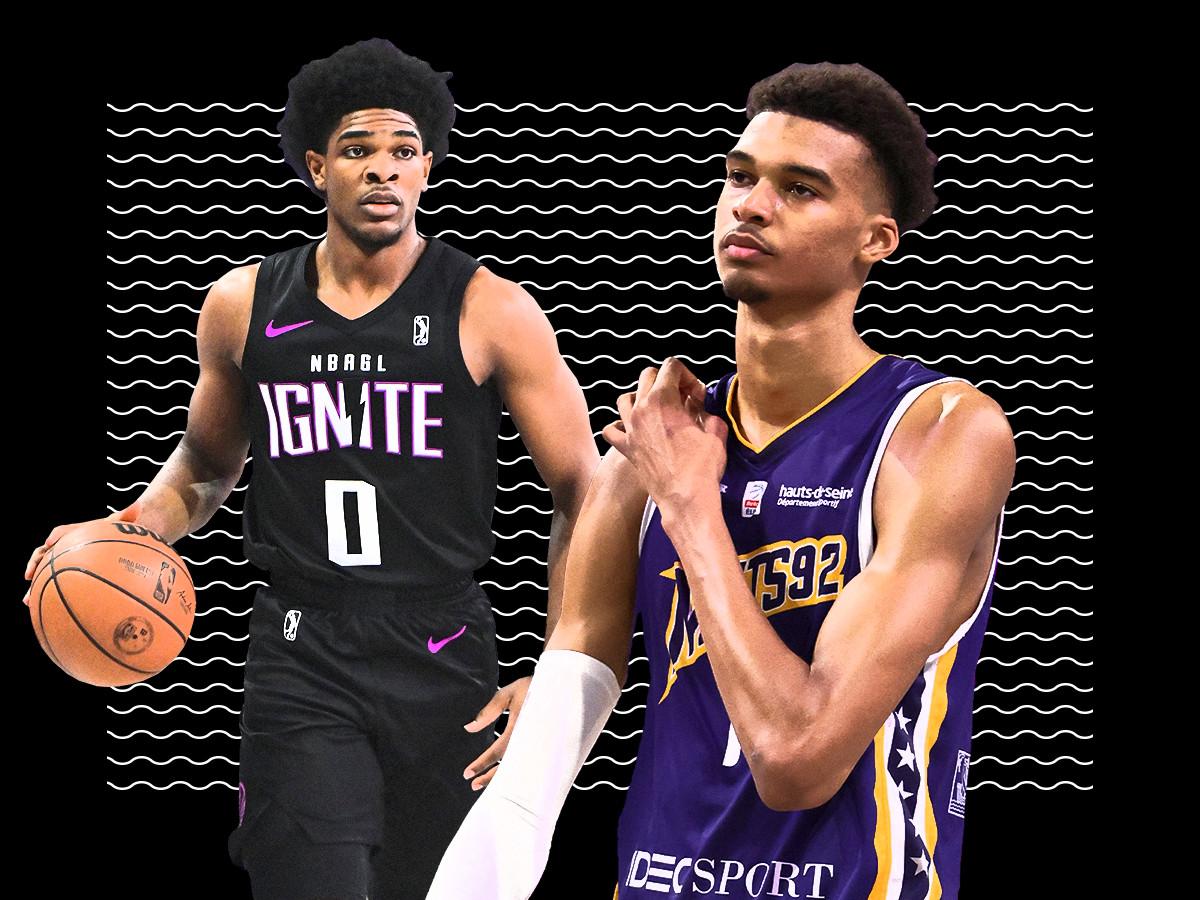The importance of the NBA draft lottery is sometimes overstated, as few winners actually luck into a franchise player who can kick-start a dynasty. Out of the last 35 no. 1 picks, only three have won a championship with the team that drafted them: LeBron James and Kyrie Irving (both with Cleveland) and Tim Duncan (with San Antonio).
But the importance of the 2023 draft lottery in particular doesn’t seem overblown. How can it be when the victor will receive, well, Victor Wembanyama, the 7-foot-3 French wunderkind who might be a Lebron- and Duncan-level prospect?
Wembanyama is “the NBA’s greatest prospect in decades, with the ceiling to be an all-time great,” our Kevin O’Connor says. Wemby rates as the top prospect on everyone’s draft board and has a 99.5 percent probability of going no. 1, per FanDuel odds. And on Tuesday night, a set of special Ping-Pong balls will determine which team can draft him next month.
So, as we approach the lottery and as Wembanyama wraps up his regular-season schedule in France and prepares for the playoffs with Metropolitans 92, it’s worth taking a moment to examine just what kind of standout the NBA will gain next season. KOC and other draftniks have the scouting side covered—but here, we’ll cover the stats, because Wembanyama excels just as much through that lens.
At the age of 19, Wembanyama leads LNB Pro A—France’s topflight basketball league—in points, rebounds, and blocks. (In blocks specifically, Wembanyama has nearly double the next-closest player’s total.) He’s averaging 21.8 points, 10.6 rebounds, 2.4 assists, and 3.6 blocks per game. The only Division I player in the last 30 years to average 20-10-2 on offense with at least three blocks per game, incidentally, is Duncan (as a senior at Wake Forest).
But Wembanyama isn’t playing at the college level; he’s spending his predraft season in Europe, so it makes more sense to compare his statistics to those of the top international prospects who came before him. From RealGM and Basketball Reference, we have data for 25 previous lottery picks who were playing in an international league, ranging from Pau Gasol in 2001 to Ousmane Dieng in 2022. Compared to this group, too, Wembanyama is a wonder.
(Note that not every international lottery pick this century has comprehensive statistics, unfortunately. Data from the early-2000s Chinese Basketball Association isn’t available, for instance, which means Yao Ming’s reported 32 points and 19 rebounds per game aren’t accounted for here.)
Compared to those 25 previous international lottery picks, Wembanyama ranks first in points per game, first in rebounds per game, and first in blocks per game. Playing more than 30 minutes per contest helps with the counting stats—but Wembanyama still ranks first in points, second in rebounds, and second in blocks per 36 minutes.
Wembanyama also makes a healthy number of 3-pointers for a player of any size, let alone someone who’d immediately tie for the tallest player in the NBA. And he ranks first in free throw attempts and makes 83 percent of his shots from the stripe, both of which demonstrate his aptitude for collecting easy points even when his shot isn’t falling.
Victor Wembanyama Vs. Other Lottery Picks From International Leagues
Wembanyama’s shooting numbers aren’t quite as stellar as his box score stats. While he makes a lot of 3-pointers, especially for a man his size, he does so by taking a lot of them. Wembanyama plays in an offensive system that gives him free rein with the ball in his hands—his 31 percent usage rate in France is about what Devin Booker, Steph Curry, and Kevin Durant recorded this season—and he has a penchant for forcing pull-up jumpers, which drags his overall shooting efficiency down to the middle of the pack among this group of international lottery picks.
Victor Wembanyama Vs. Other Lottery Picks From International Leagues (Shooting Stats)
Yet while his highlight reel consists of one-legged 3-pointers and Euro-step dunks, Wembanyama excels most—and will presumably be an impact player from his first day in the NBA—on the defensive end. By virtue of his sheer height, Wembanyama is a reliable rebounder, and he has an absurd 10 percent block rate this season. For context, Jaren Jackson Jr. led the NBA with a 9.6 percent block rate (and won the Defensive Player of the Year award because of it), and Manute Bol is the only qualifying player in NBA history to reach double digits in a season.
Among other highly drafted European bigs, Wembanyama’s block rate is essentially double what Kristaps Porzingis had before he was drafted, and the gap is even wider when comparing Wembanyama to Jonas Valanciunas and Gasol.
Victor Wembanyama Vs. Other Lottery Picks From International Leagues (Advanced Stats)
There’s an asterisk in this chart because Wembanyama would probably be no. 1 in player efficiency rating if we had PER data from Gasol’s entire 2000-01 season, versus just a small subset of it.
That’s a meaningful indicator though. Despite a few big whiffs—like Georgios Papagiannis, who had excellent advanced stats in limited playing time in Greece before unexpectedly being picked in the lottery and flaming out in Sacramento—a lottery prospect’s performance in Europe has generally been predictive of their eventual performance stateside.
For the 24 previous international lottery picks who went on to play in the NBA (Fran Vázquez, picked 11th by the Magic in 2005, never did), there’s a 0.78 correlation between their PER in international play during their draft season and their career PER in the NBA. Correlation works on a scale of 0 to 1, so 0.78 means there’s a strong relationship between the stats.
All those disparate statistics point to the same overall conclusion: Wembanyama is an incredible prospect and a more accomplished international youngster than possibly any others who came before him.
Granted, given the way scouts have talked about the impending no. 1 pick for the past year-plus, we knew that much already. But it’s still worth appreciating the comparisons and, in particular, zooming in on how Wembanyama compares to Luka Doncic, the NBA’s best European lottery import of the 21st century. (Note the lottery qualifier there, as it excludes Giannis Antetokounmpo and Nikola Jokic—though Jokic, the no. 41 pick in 2014, posted excellent statistics in the Adriatic League before joining the NBA, providing another piece of evidence that performance tends to translate from one side of the Atlantic to the other.)
In their respective final seasons in Europe, Wembanyama was a much more impactful defender than Doncic, and he was effectively Luka’s equal on the other end. That latter bit might be a surprise, because Luka is a one-man offense of the highest order, but Wembanyama outscored him, posted nearly identical shooting percentages, and even got to the line more than Doncic—which is a fantastic indicator, because Doncic is now one of the most prolific free throw takers in the NBA.
Victor Wembanyama Vs. Luka Doncic in Final Season in Europe
Here’s where we take a breath, though, and turn to a couple of colossal caveats. We don’t want to get too far out over our skis on this trip to the Alps.
Wembanyama is dominating the French league, which offers only a middling quality of competition. In 2017, international draft expert Fran Fraschilla ranked LNB Pro A seventh out of 12 non-NBA leagues around the world. By comparison, Fraschilla ranked the EuroLeague and Spain’s Liga ACB first and second, respectively, and ESPN’s Kevin Pelton calculates that the gap between the French league and the EuroLeague is about as large as the gap between the EuroLeague and the NBA. Doncic’s MVP performance as a teenager in both the EuroLeague and the Spanish league is more impressive than Wembanyama’s best-in-the-league showing in France.
(China’s league ranked last out of the 12 in Fraschilla’s list, by the way. Yao’s domination in Shanghai looks considerably less potent with that context.)
Or, put another way, Wembanyama ranks fourth in the French league this season in points per 36 minutes. The three players ahead of him are 35-year-old Nando de Colo, who scarcely made a dent during a two-season NBA run in his mid-20s, and a pair of American guards who never made it to the NBA: Matt Morgan and 5-foot-9 Marcus Keene.
Moreover, because his team isn’t involved in international European competition, Wembanyama’s sample size is smaller than Doncic’s. The future Maverick played 73 games in his final season before being drafted; Wembanyama, for comparison, is at only 34 games this season—which might be better for his long-term health but means we should take his numbers with a grain of salt.
Thus, Pelton’s projection system, while still enamored of Wembanyama’s potential, doesn’t grade his statistical résumé as highly as scouts grade his overall body of work.
Odds are that Wembanyama will require some sort of adjustment period upon arriving in the NBA due to the sheer jump in the quality of competition around him. We probably shouldn’t expect Wembanyama to come in as a rookie and lead the league in blocks.
On the other hand, Luka was a star right away, and any theoretical adjustment period for Wembanyama could be offset by his work ethic and continuing evolution as a basketball player. His subpar 3-point percentage, for instance, could improve in line with his mid-80s shooting stroke from the foul line. Playing with NBA-caliber guards who can set him up for easier shots could also help his middling scoring efficiency, even as he faces tougher defenders; the assists leader for Metropolitans 92 playing next to Wembanyama is Tremont Waters, who appeared in 40 NBA games from 2019 through 2022.
Just how much Wembanyama will need to adjust and how much he’ll improve as his body matures remain to be seen—those are questions for his NBA future, which effectively begins Tuesday night. His unprecedented combination of size and skill already presents him as a sure thing once he arrives, barring injury. But his domination of a decent European league as a teenager only adds to that mystique. Even compared to other highly touted prospects who preceded him, Wembanyama is one of a kind.

